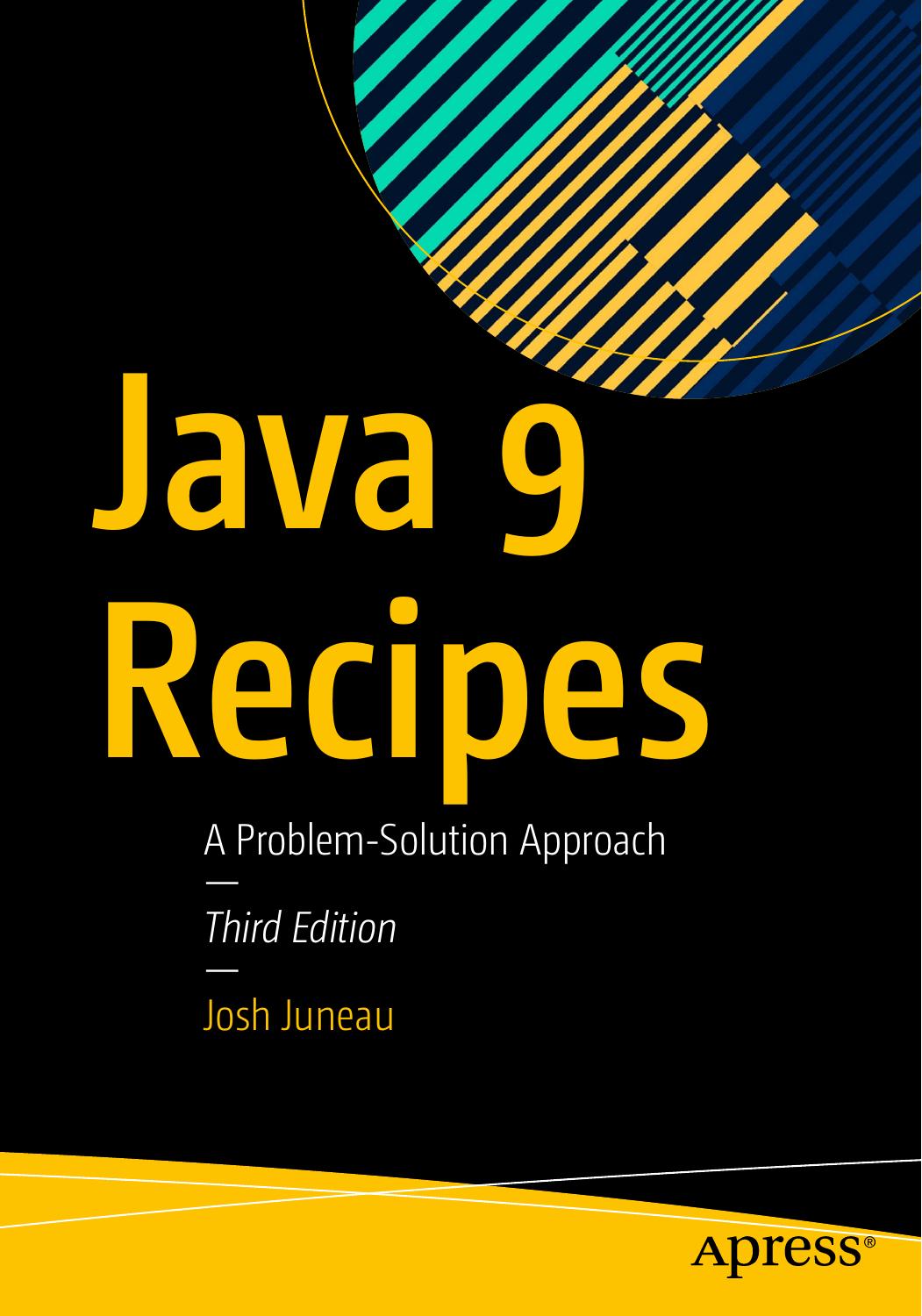Chapter 5: Object-Oriented Java
5-1. Controlling Access to Members of a Class
How It Works
5-2. Making Private Fields Accessible to Other Classes
How It Works
5-3. Creating a Class with a Single Instance
How It Works
5-4. Generating Instances of a Class
How It Works
5-5. Creating Reusable Objects
How It Works
5-6. Defining an Interface for a Class
How It Works
5-7. Modifying Interfaces Without Breaking Existing Code
How It Works
5-8. Constructing Instances of the Same Class with Different Values
How It Works
5-9. Interacting with a Class via Interfaces
How It Works
5-10. Making a Class Cloneable
How It Works
5-11. Comparing Objects
How It Works
5-12. Extending the Functionality of a Class
How It Works
5-13. Defining a Template for Classes to Extend
How It Works
5-14. Increasing Class Encapsulation
How It Works
Summary
Chapter 6: Lambda Expressions
6-1. Writing a Simple Lambda Expression
How It Works
6-2. Enabling the Use of Lambda Expressions
How It Works
6-3. Invoking Existing Methods by Name
How It Works
6-4. Sorting with Fewer Lines of Code
How It Works
6-5. Filtering a Collection of Data
How It Works
6-6. Implementing Runnable
How It Works
6-7. Replacing Anonymous Inner Classes
How It Works
6-8. Accessing Class Variables from a Lambda Expression
How It Works
6-9. Passing Lambda Expressions to Methods
How It Works
Summary
Chapter 7: Data Sources and Collections
7-1. Defining a Fixed Set of Related Constants
How It Works
7-2. Designing Intelligent Constants
How It Works
7-3. Executing Code Based on a Specified Value
How It Works
7-4. Working with Fixed-Size Arrays
How It Works
7-5. Safely Enabling Types or Methods to Operate on Objects of Various Types
How It Works
7-6. Working with Dynamic Arrays
How It Works
7-7. Making Your Objects Iterable
How It Works
7-8. Iterating Over Collections
How It Works
7-9. Iterating Over a Map
How It Works
7-10. Executing Streams in Parallel
How It Works
Summary
Chapter 8: Input and Output
8-1. Serializing Java Objects
How It Works
8-2. Serializing Java Objects More Efficiently
How It Works
8-3. Serializing Java Objects as XML
How It Works
8-4. Creating a Socket Connection and Sending Serializable Objects Across the Wire
How It Works
8-5. Obtaining the Java Execution Path
How It Works
8-6. Copying a File
How It Works
8-7. Moving a File
How It Works
8-8. Creating a Directory
How It Works
8-9. Iterating Over Files in a Directory
How It Works
8-10. Querying (and Setting) File Metadata
How It Works
8-11. Monitoring a Directory for Content Changes
How It Works
8-12. Reading Property Files
How It Works
8-13. Uncompressing Files
How It Works
8-14. Managing Operating System Processes
How It Works
Summary
Chapter 9: Exceptions and Logging
9-1. Catching Exceptions
How It Works
9-2. Guaranteeing a Block of Code Is Executed
How It Works
9-3. Throwing Exceptions
How It Works
9-4. Catching Multiple Exceptions
How It Works
9-5. Catching the Uncaught Exceptions
How It Works
9-6. Managing Resources with try/catch Blocks
How It Works
9-7. Creating an Exception Class
How It Works
9-8. Rethrowing the Caught Exception
How It Works
9-9. Logging Events Within Your Application
How It Works
9-10. Rotating and Purging Logs
How It Works
9-11. Logging Exceptions
How It Works
9-12. Logging with the Unified JVM Logger
How It Works
Summary
Chapter 10: Concurrency
10-1. Starting a Background Task
How It Works
10-2. Updating (and Iterating) a Map
How It Works
10-3. Inserting a Key into a Map Only If the Key Is Not Already Present
How It Works
10-4. Iterating Through a Changing Collection
How It Works
10-5. Coordinating Different Collections
How It Works
10-6. Splitting Work into Separate Threads
How It Works
10-7. Coordinating Threads
How It Works
10-8. Creating Thread-Safe Objects
How It Works
10-9. Implementing Thread-Safe Counters
How It Works
10-10. Breaking Down Tasks into Discrete Units of Work
How It Works
10-11. Updating a Common Value Across Multiple Threads
How It Works
10-12. Executing Multiple Tasks Asynchronously
How It Works
Summary
Chapter 11: Debugging and Unit Testing
11-1. Understanding Exceptions
How It Works
11-2. Locking Down Behavior of Your Classes
How It Works
11-3. Scripting Your Unit Tests
How It Works
11-4. Finding Bugs Early
How It Works
11-5. Monitoring Garbage Collection in Your Application
How It Works
11-6. Obtaining a Thread Dump
How It Works
Summary
Chapter 12: Unicode, Internationalization, and Currency Codes
12-1. Converting Unicode Characters to Digits
How It Works
12-2. Creating and Working with Locales
How It Works
12-3. Setting the Default Locale
How It Works
12-4. Matching and Filtering Locales
How It Works
12-5. Searching Unicode with Regular Expressions
How It Works
12-6. Overriding the Default Currency
How It Works
12-7. Converting Byte Arrays to and from Strings
How It Works
12-8. Converting Character Streams and Buffers
How It Works
12-9. Setting the Search Order of Locale-Sensitive Services
How It Works
Summary
Chapter 13: Working with Databases
13-1. Connecting to a Database
How It Works
13-2. Handling Connection and SQL Exceptions
How It Works
13-3. Querying a Database and Retrieving Results
How It Works
13-4. Performing CRUD Operations
How It Works
13-5. Simplifying Connection Management
How It Works
13-6. Guarding Against SQL Injection
How It Works
13-7. Performing Transactions
How It Works
13-8. Creating a Scrollable ResultSet
How It Works
13-9. Creating an Updatable ResultSet
How It Works
13-10. Caching Data for Use When Disconnected
How It Works
13-11. Joining RowSet Objects When Not Connected to the Data Source
How It Works
13-12. Filtering Data in a RowSet
How It Works
13-13. Querying and Storing Large Objects
How It Works
13-14. Invoking Stored Procedures
How It Works
13-15. Obtaining Dates for Database Use
How It Works
13-16. Closing Resources Automatically
How It Works
Summary
Chapter 14: JavaFX Fundamentals
14-1. Creating a Simple User Interface
How It Works
14-2. Drawing Text
How It Works
14-3. Changing Text Fonts
How It Works
14-4. Creating Shapes
How It Works
14-5. Assigning Colors to Objects
How It Works
14-6. Creating Menus
How It Works
14-7. Adding Components



